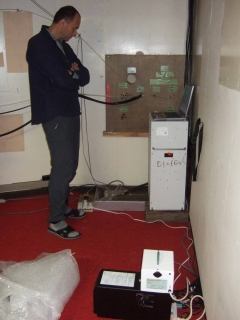On the importance of Mt Fuji Weather station for monitoring atmospheric composition changes

Dr.Paolo Laj
Information on atmospheric composition, from the local to the global scale, is of strategic value. However, despite substantial improvements in the last decade in the development of Earth
observing tools, there is still a crucial need for both consolidation of the existing observation infrastructure and development of a more efficient observing system that would narrow major data
and information gaps, and assist stake holders in planning new investments. Atmospheric observations should provide well documented, global observations of the chemical composition and physical
properties of the atmosphere from pole to pole with temporal, horizontal and vertical resolution sufficient to 1) satisfy and verify current legislation, 2) validate and help to improve our
understanding of atmospheric processes, 3) understand the relationship between the atmosphere, the oceans and the land masses, 4) permit accurate predictions of future atmospheric states by
providing inputs to forecast models, and 5) support answering new questions that will only emerge in future.
Numerous papers have been published that discuss network design strategies and it results that one of the most limitating gap in the current observing system for atmospheric composition changes
results from uneven global and regional coverage. Entire regions of the World are characterized by very limited coverage of entire areas, particularly of remote ones. A clear conclusion emerging
from the analysis of operational networks points to the need for additional information from the free troposphere. Many variables have strong vertical profiles as a result of dynamic or chemical
processes and a strong vertical distribution of sources and sinks (e.g., most sources are at ground level). The transformation of column density into in situ concentrations requires information
on the vertical structure of the atmosphere. Observations of the free troposphere are also needed to understand long-range transport, climate change, trends in the oxidizing capacity of the
atmosphere, and as a ‘baseline’ for the characterization of atmospheric chemistry and physics. GCM-CTMs have advanced to the point where they are able to predict ‘background’ concentrations
adequately, but miss events. These are relevant for air quality. While greenhouse gases and stratospheric ozone have been well studied, global air quality is not. There are large gaps in our
understanding of the role that hemispheric transport plays in regional air quality. Continuous, long-term measurements of the free troposphere ? spatially more representative than observations
from within the boundary layer ? are also needed for satellite validation. Key compounds include PAN, NMHCs, OVOCs, BC and various other aerosol variables. An integrated network of satellite
observations, global models and high elevation/mountain top observations would greatly add to our understanding of hemispheric transport.
My recent visits to Mt. Fuji station in July 2008 and 2009 confirmed that the place seems ideal to complete a very scarce Asian network of high altitude stations. A first aspect, of fundamental
importance is linked to logistical aspects. This is clearly a limitation for high altitude sites, especially above 3000 m when adverse meteorological conditions pose difficult problems from
access to the site to instrument operation. NPO staff has developed a very needed knowledge in support of researcher’s activities that should not be jeopardized.
A second aspect is clearly linked to scientific reasons. China economic development leads to hugely increasing emissions which are severely under-sampled. The most consistent information
currently comes from satellite observations. However, for many reasons, satellite observations difficult and less reliable, and calls for enhanced efforts related to in situ measurements. A
permanent (or semi permanent) sampling location at Mt Fuji, directly influenced by emissions taking place several thousands of kilometers upwind is of fundamental importance and will certainly
provide very important information on the global impact of emission from China. I do not see any other location with the potential of concentrating the effort of many excellent scientific teams
as Mt. Fuji does.
This is clearly why ensuring continuation of atmospheric measurement on top of Mt Fuji can really be seen as a legacy to future generation of scientists. I strongly advise to maintain the
Japanese monitoring expertise at the station and I am convinced that very innovative results will be produced by previous scientific campaigns at the station.
Paolo Laj
Senior Scientist at Laboratoire de Glaciologie and Geophysique de l’Environnement, University of Grenoble- CNRS, Grenoble, France
 At the Lab. of Mt.Fuji
At the Lab. of Mt.Fuji
